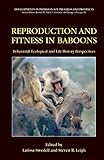Reproduction and Fitness in Baboons: Behavioral, Ecological, and Life History Perspectives / edited by Larissa Swedell, Steven R. Leigh.
Tipo de material: TextoSeries Developments in Primatology: Progress and ProspectsEditor: Boston, MA : Springer US, 2006Descripción: viii, 322 páginas, recurso en líneaTipo de contenido:
TextoSeries Developments in Primatology: Progress and ProspectsEditor: Boston, MA : Springer US, 2006Descripción: viii, 322 páginas, recurso en líneaTipo de contenido: - texto
- computadora
- recurso en línea
- 9780387336749
- QH359-425
Springer eBooks
Perspectives on Reproduction and Life History in Baboons -- Perspectives on Reproduction and Life History in Baboons -- Reproductive Behavior and Mating Strategies -- Infant Mortality, Paternity Certainty, and Female Reproductive Strategies in Hamadryas Baboons -- Female Behavioral Strategies of Hybrid Baboons in the Awash National Park, Ethiopia -- Hybrid Baboons and the Origins of the Hamadryas Male Reproductive Strategy -- The Social and Ecological Flexibility of Guinea Baboons: Implications for Guinea Baboon Social Organization and Male Strategies -- Social Organization, Reproductive Systems, and Mediation of Baboon Endogenous Virus (BaEV) Copy Number in Gelada, Hamadryas, and Other Papio Baboons -- Life History, Development, and Parenting Strategies -- Reproduction, Mortality, and Female Reproductive Success in Chacma Baboons of the Okavango Delta, Botswana -- Maternal Characteristics and Offspring Growth in Chacma Baboons: A Life History Perspective -- Whose Life Is It Anyway? Maternal Investment, Developmental Trajectories, and Life History Strategies in Baboons -- Ontogeny, Life History, and Maternal Investment in Baboons -- Testicular Size, Developmental Trajectories, and Male Life History Strategies in Four Baboon Taxa -- The Evolutionary Past and the Research Future: Environmental Variation and Life History Flexibility in a Primate Lineage.
This volume brings together current research on the behavior, ecology, reproduction, and life history - and the interrelations among these variables - of baboons of the genus Papio. Baboons, found throughout Africa and into Arabia, represent one of the best-known primate lineages, renowned for their ecological and behavioral flexibility and adaptability. These characteristics are intimately intertwined with features of baboon life history and reproduction. Contributors to this volume, representing several major, long-term research projects from throughout the African continent, explore reproductive behavior and strategies of adult male and female baboons in a variety of ways. In Part I, authors explore various aspects of baboon reproduction and social organization, focusing on issues such as infanticide, mating strategies and investment, hybridization and genetics in examining how adults go about mating and reproducing. In Part II, these aspects of life are juxtaposed with detailed examinations of life history and parental investment. Together, the chapters in this volume explore reproduction and parenting from a variety of angles and motivate research from both the parental and offspring perspectives and at a variety of taxonomic levels. Articulating studies of reproduction with those of life history conveys a richly detailed portrait of life phases with critical evolutionary consequences. These lines of inquiry together forge new ways to investigate the life periods that matter most in evolution.
Para consulta fuera de la UANL se requiere clave de acceso remoto.


